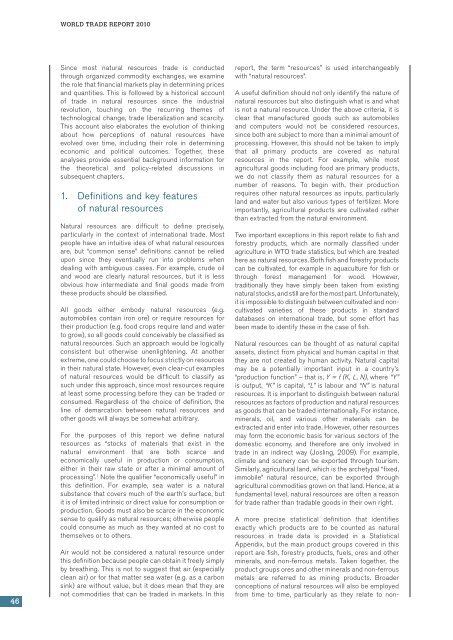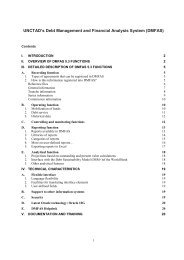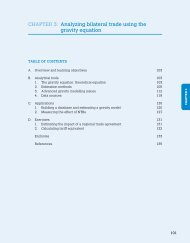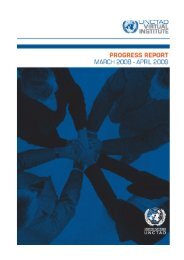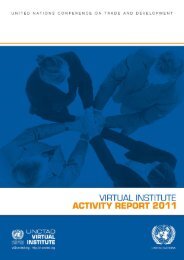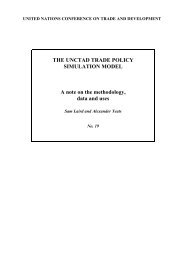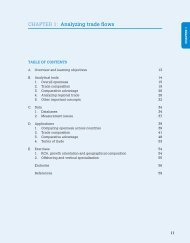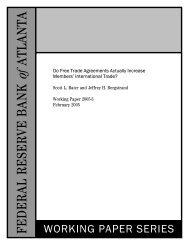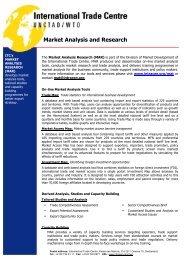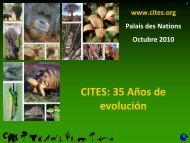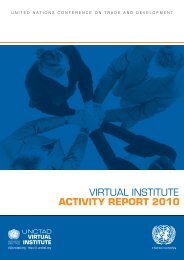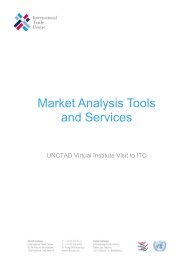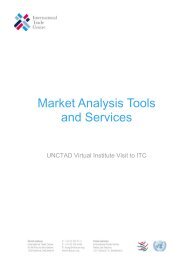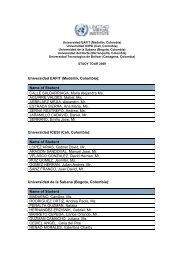WTO: World Trade Report 2010 - World Trade Organization
WTO: World Trade Report 2010 - World Trade Organization
WTO: World Trade Report 2010 - World Trade Organization
You also want an ePaper? Increase the reach of your titles
YUMPU automatically turns print PDFs into web optimized ePapers that Google loves.
world trade report <strong>2010</strong><br />
46<br />
Since most natural resources trade is conducted<br />
through organized commodity exchanges, we examine<br />
the role that financial markets play in determining prices<br />
and quantities. This is followed by a historical account<br />
of trade in natural resources since the industrial<br />
revolution, touching on the recurring themes of<br />
technological change, trade liberalization and scarcity.<br />
This account also elaborates the evolution of thinking<br />
about how perceptions of natural resources have<br />
evolved over time, including their role in determining<br />
economic and political outcomes. Together, these<br />
analyses provide essential background information for<br />
the theoretical and policy-related discussions in<br />
subsequent chapters.<br />
1. Definitions and key features<br />
of natural resources<br />
Natural resources are difficult to define precisely,<br />
particularly in the context of international trade. Most<br />
people have an intuitive idea of what natural resources<br />
are, but “common sense” definitions cannot be relied<br />
upon since they eventually run into problems when<br />
dealing with ambiguous cases. For example, crude oil<br />
and wood are clearly natural resources, but it is less<br />
obvious how intermediate and final goods made from<br />
these products should be classified.<br />
All goods either embody natural resources (e.g.<br />
automobiles contain iron ore) or require resources for<br />
their production (e.g. food crops require land and water<br />
to grow), so all goods could conceivably be classified as<br />
natural resources. Such an approach would be logically<br />
consistent but otherwise unenlightening. At another<br />
extreme, one could choose to focus strictly on resources<br />
in their natural state. However, even clear-cut examples<br />
of natural resources would be difficult to classify as<br />
such under this approach, since most resources require<br />
at least some processing before they can be traded or<br />
consumed. Regardless of the choice of definition, the<br />
line of demarcation between natural resources and<br />
other goods will always be somewhat arbitrary.<br />
For the purposes of this report we define natural<br />
resources as “stocks of materials that exist in the<br />
natural environment that are both scarce and<br />
economically useful in production or consumption,<br />
either in their raw state or after a minimal amount of<br />
processing”. 1 Note the qualifier “economically useful” in<br />
this definition. For example, sea water is a natural<br />
substance that covers much of the earth’s surface, but<br />
it is of limited intrinsic or direct value for consumption or<br />
production. Goods must also be scarce in the economic<br />
sense to qualify as natural resources; otherwise people<br />
could consume as much as they wanted at no cost to<br />
themselves or to others.<br />
Air would not be considered a natural resource under<br />
this definition because people can obtain it freely simply<br />
by breathing. This is not to suggest that air (especially<br />
clean air) or for that matter sea water (e.g. as a carbon<br />
sink) are without value, but it does mean that they are<br />
not commodities that can be traded in markets. In this<br />
report, the term “resources” is used interchangeably<br />
with “natural resources”.<br />
A useful definition should not only identify the nature of<br />
natural resources but also distinguish what is and what<br />
is not a natural resource. Under the above criteria, it is<br />
clear that manufactured goods such as automobiles<br />
and computers would not be considered resources,<br />
since both are subject to more than a minimal amount of<br />
processing. However, this should not be taken to imply<br />
that all primary products are covered as natural<br />
resources in the report. For example, while most<br />
agricultural goods including food are primary products,<br />
we do not classify them as natural resources for a<br />
number of reasons. To begin with, their production<br />
requires other natural resources as inputs, particularly<br />
land and water but also various types of fertilizer. More<br />
importantly, agricultural products are cultivated rather<br />
than extracted from the natural environment.<br />
Two important exceptions in this report relate to fish and<br />
forestry products, which are normally classified under<br />
agriculture in <strong>WTO</strong> trade statistics, but which are treated<br />
here as natural resources. Both fish and forestry products<br />
can be cultivated, for example in aquaculture for fish or<br />
through forest management for wood. However,<br />
traditionally they have simply been taken from existing<br />
natural stocks, and still are for the most part. Unfortunately,<br />
it is impossible to distinguish between cultivated and noncultivated<br />
varieties of these products in standard<br />
databases on international trade, but some effort has<br />
been made to identify these in the case of fish.<br />
Natural resources can be thought of as natural capital<br />
assets, distinct from physical and human capital in that<br />
they are not created by human activity. Natural capital<br />
may be a potentially important input in a country’s<br />
“production function” – that is, Y = f (K, L, N), where “Y”<br />
is output, “K” is capital, “L” is labour and “N” is natural<br />
resources. It is important to distinguish between natural<br />
resources as factors of production and natural resources<br />
as goods that can be traded internationally. For instance,<br />
minerals, oil, and various other materials can be<br />
extracted and enter into trade. However, other resources<br />
may form the economic basis for various sectors of the<br />
domestic economy, and therefore are only involved in<br />
trade in an indirect way (Josling, 2009). For example,<br />
climate and scenery can be exported through tourism.<br />
Similarly, agricultural land, which is the archetypal “fixed,<br />
immobile” natural resource, can be exported through<br />
agricultural commodities grown on that land. Hence, at a<br />
fundamental level, natural resources are often a reason<br />
for trade rather than tradable goods in their own right.<br />
A more precise statistical definition that identifies<br />
exactly which products are to be counted as natural<br />
resources in trade data is provided in a Statistical<br />
Appendix, but the main product groups covered in this<br />
report are fish, forestry products, fuels, ores and other<br />
minerals, and non-ferrous metals. Taken together, the<br />
product groups ores and other minerals and non-ferrous<br />
metals are referred to as mining products. Broader<br />
conceptions of natural resources will also be employed<br />
from time to time, particularly as they relate to non-


